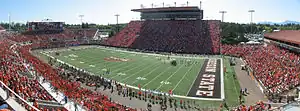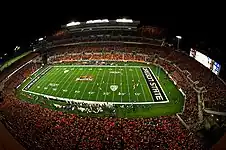 View from southeast end zone in 2023 | |
 Corvallis Location in the United States 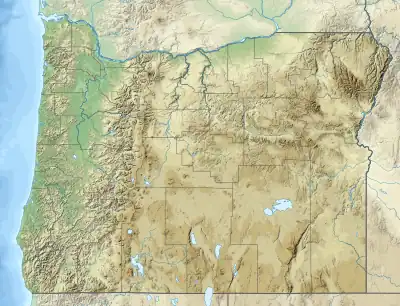 Corvallis Location in Oregon | |
| Former names | Parker Stadium (1953–June 1999) |
|---|---|
| Address | 2600 SW Western Blvd |
| Location | Oregon State University Corvallis, Oregon, U.S. |
| Coordinates | 44°33′32″N 123°16′52″W / 44.559°N 123.281°W |
| Owner | Oregon State University |
| Operator | Oregon State University |
| Capacity | 35,548 (2023–present)
Former capacity: |
| Surface | FieldTurf (2005–present)
Former surfaces: |
| Construction | |
| Broke ground | September 1952 |
| Opened | November 14, 1953[4][5] |
| Renovated | 2005, 2007, 2016, 2021-23 |
| Expanded | 1958, 1965, 1967, 2005 |
| Construction cost | $1 million ($10.9 million in 2022[6]) $80 million (2005 renovation) |
| Architect | Moffatt, Nichol & Taylor[7] HNTB (renovations) |
| General contractor | Wall, Bertram and Sanford[8] |
| Tenants | |
| Oregon State Beavers (NCAA) (1953–present) | |
| Website | |
| osubeavers.com/reser-stadium | |
Reser Stadium is an outdoor athletic stadium in the northwest United States, on the campus of Oregon State University in Corvallis, Oregon. The home of the Oregon State Beavers of the Pac-12 Conference, it opened in 1953 as Parker Stadium and was renamed in 1999.[9][10]
Renovations for a new southwest grandstand decreased the seating capacity to 35,548 starting with the 2023 season.[11] The FieldTurf playing field runs northwest to southeast, at an approximate elevation of 240 feet (73 m) above sea level,[12] with the press box above the grandstand on the southwest sideline.
History and use
From 1910 to 1953, the Beavers played their home games at Bell Field (now the site of the Dixon Recreation Center), and also played as many as four games a year at Multnomah Stadium (now Providence Park) in Portland.[10] In 1948, Oregon State president August L. Strand, athletic director Spec Keene, and Portland businessman Charles T. Parker (1885–1977)[13] met to plan a replacement for Bell Field. Parker, a 1907 alumnus,[10] kicked off the stadium fundraising campaign in 1949 and made significant contributions of his own.[10][14] In 1952, construction of the stadium began; for Parker's efforts and contributions, the stadium was named in his honor.[15] The first game was played on Homecoming, November 14, 1953, and the Beavers defeated Washington State 7–0.[4][10] At the time, it seated 28,000.[16]
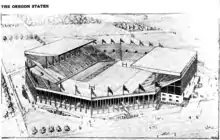
Parker was renovated in 1958, 1965, and 1967, reaching a capacity of approximately 40,500 seats, but the architect's full intent never came to fruition.[17] The roof over the main southwest grandstand was approved in 1988,[18][19] and with the completion of the original Valley Football Center behind the northwest end zone, capacity was reduced to 35,362 in 1990; the roof and new press box were completed in 1991.
The stadium was renamed in June 1999 to honor Al and Pat Reser, owners of Reser's Fine Foods.[9][10] The couple both graduated from Oregon State in 1960,[20] and are major donors to the university and Beavers athletics,[9][21] though Al died at the age of 74 in 2010.[22] The Parker name is still honored at Parker Plaza,[9] located between Reser and Gill Coliseum, the site of many pregame activities.
The stadium is located on the southwest corner of the Oregon State campus at the intersection of SW 26th Street and SW Western Boulevard in Corvallis. In addition to football, intramural and club sports also use the facility occasionally.
Reser Stadium alternates with Autzen Stadium at the University of Oregon in hosting the annual rivalry game with the Ducks. Since 1954, the games in even-numbered years have been played in Corvallis, odd-numbered in Eugene.
Playing surface
Through the 1968 season, the stadium's playing surface was natural grass. AstroTurf was installed in 1969,[23] and replaced in 1974 and 1977.[24][25] The brand was switched to All-Pro artificial turf in 1984,[26][27] which was in place for 15 seasons,[27] replaced in 1999 with AstroTurf 12/2000. Infilled FieldTurf debuted in 2005,[28] and was replaced prior to the 2012 season.[21]
Expansion and upgrades
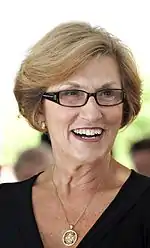
Through the 2004 season, the official capacity of the stadium stood at 35,362. In 2003 the Raising Reser campaign was initiated, which resulted in an increase of seating capacity to 43,300 for the 2005 season by way of constructing a new grandstand along the northeast sideline.[21][28] "Phase Two" of the Raising Reser project was completed between the 2006 and 2007 football seasons; it enclosed the horseshoe in the southeast end zone with continuous seating in the corners. This addition raised total seating capacity to 45,674 and included the 150-by-30-foot (46 m × 9 m) ProStar Digital VideoPlus Display screen.[21]
During the planned Phase Three, the upper level will extend through the southwest grandstand.
The north end zone is also home to the Valley Football Center, which houses a large weight room, offices and meeting facilities, reserved primarily for coaches and administrators within the football program. In December 2014, Victory Through Valley, an expansion to the stadium and Valley Football Center was announced as part of $42 million in upgrades. The renovations were scheduled to begin in Fall 2015 and were completed by the beginning of the 2016 football season. Victory Through Valley upgrades included a new auditorium, coaches offices, team room, locker room, rehab facilities, and hall of fame. The new additions and upgrades have helped with recruiting, competitiveness, and functionality.
On February 4, 2021, renovations for the outdated 16,956-seat southwest grandstand were revealed to the public. [29] Construction began on December 1, 2021, and will be completed in time for the 2023 football season. Although the renovation ultimately lowered Reser Stadium's total capacity to 35,548, the new grandstand is larger in size than its predecessor. [30] The grandstand is taller than the old southwest side, allowing seats to be much closer to the field. This design feature will result in a much louder Reser Stadium, despite the reduced capacity. The design of the top deck allows for future seating expansions. The renovation will also bring the completion of a full concourse to Reser Stadium, allowing fans to walk the entirety around the field uninterrupted. A planned walkway called "Beaver Street," which will feature unique concessions as well as other amenities, will be the heart of this concourse. Other things included in this renovation project include, replacing the current, crowded, small and old pressbox on the west side grandstand, increase in restrooms and concession areas, repurposing underutilized east side club seating, creating more loge boxes, premium spaces and suites, an improvement to the scoreboard, relocating the visitor's locker room (It currently resides in the basement of adjacent Gill Coliseum) and creating spaces via a public/private partnership that will allow for year-round use of the stadium. And not exactly a part of Reser Stadium, but still on the property, they will be building a Wellness Care Facility on the Southeast side of the stadium, for students, faculty, staff, and community members. And on the new west side grandstand they will be building a Student Welcome Center.[31]
Notable Features
Large Oversized Chainsaw
There is an oversized chainsaw standing in the Reser’s Terrace section. “For us, the chainsaw is an in-venue piece, that goes down well in front of a home crowd at Reser Stadium,” said Sara Elcano, senior associate athletic director of external operations. [32]
Retired Numbers
Heisman Trophy winner Terry Baker's number "11" is currently the only retired number hanging on the Valley Football Center overlooking the Reser Terrace section in the north end zone. [33][34] And, although not a retired number Oregon State has "AL" displayed opposite Terry Baker's number "11" for long time donor/philanthropist/contributor Al Reser.
IronMan Statue
A large statue in the southwest end zone corner of the stadium was placed in 2003 to commemorate the 1933 'Iron Men' Team.
On Oct. 21, 1933, using only 11 players the full 60 minutes, Oregon State College held two-time defending national champion and No. 1-ranked USC to a scoreless tie, thus ending the nation's longest winning streak at 25. It is believed this is the only time in NCAA history that a defending national champion and No. 1-ranked school was toppled from the ranks by a team using only 11 men the entire game.
The sculpture was donated by William "Bill" Tomsheck: The last surviving Ironman member and long-time Corvallis, OR resident. [35]
"Beaver Fans 1" Sculpture
Visitors to Reser Stadium are welcomed with two very impressive and eye-catching bronze sculptures of real-life fans celebrating the Oregon State Beavers football team as they enter the east sideline entrance. They literally pop out of the brick towers they are mounted to and the scene is of a celebratory nature, with various people of yelling or smiling, men and women, most likely for a Beaver touchdown. "Beaver Fans 1" is the first of two commissioned pieces, this sculpture was constructed in 2006, by artist and Professor of Art, Emeritus Tom Morandi created as part of a competition he applied for and won for Oregon's One Percent for Art Program. One percent of the cost of new state buildings in Oregon is required to be used towards the purchase of art. [36]
Electric Field Sculpture
Electric Field is a large metal football sculpture that is defined by linear metal and ornamented by lighted Xs and triangles that sits at an angle atop a brushed metal base in the plaza of Reser Stadium. Dennis Oppenheim completed the Sculpture in 2006, and described his piece, Electric Field, by "using the universally beautiful geometry of the football to contain the dynamic of the game by showing many different strategic movements experienced during a game. These field actions are represented by symbols of the players in the form of geometric shapes and lines of light which connect them."[37]
Attendance records
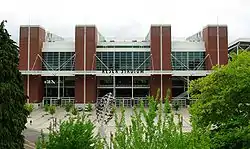
| Rank | Date | Opponent | Result | Attendance |
|---|---|---|---|---|
| 1 | November 24, 2012 | #5 Oregon | L, 48–24 | 47,249[38] |
| 2 | October 6, 2012 | Washington State | W, 19–6 | 46,579[39] |
| 3 | December 4, 2010 | #1 Oregon | L, 37–20 | 46,469[40] |
| 4 | November 29, 2008 | #19 Oregon | L, 65–38 | 46,319[40] |
| 5 | November 3, 2012 | Arizona State | W, 36–26 | 45,979[41] |
| 6 | November 15, 2008 | California | W, 34–29 | 45,969[40] |
| 7 | October 20, 2012 | Utah | W, 21–7 | 45,796[42] |
| 8 | November 29, 2014 | #2 Oregon | L, 47–19 | 45,722 |
| 9 | November 10, 2007 | Washington | W, 29–23 | 45,629[40] |
| 10 | October 30, 2010 | California | W, 35–7 | 45,439[40] |
Non-athletic uses
Apart from use from the Athletic Department, Reser Stadium is occasionally also used for various non-athletic events, particularly events such as commencement, held every June. This has allowed the stadium to hold notable speakers such as astronaut John Glenn.[43] and former first lady Michelle Obama.[44]
"Dam Jam" an annual end of the year concert celebration put on for students and community members, by students, was held a Reser Stadium in 2018 and 2019, drawing up to approximately 14,000 to 18,000 people with headliners Alison Wonderland and Super Duper Kyle in 2018 and Akon and Jesse McCartney in 2019. [45] [46] [47]
In 2005 following the opening game at the newly renovated Reser Stadium country music duo Montgomery Gentry performed.[48]
Gallery
See also
References
- ↑ Daschel, Nick (2021-12-17). "Oregon State mailbag: Official Reser capacity for 2022, transfers, biggest Beaver moment of 2021". oregonlive. Retrieved 2022-01-07.
- ↑ "Oregon State mailbag: Official Reser capacity for 2022, transfers, biggest Beaver moment of 2021 - oregonlive.com". 17 December 2021.
- ↑ "Reser Stadium". Oregon State University Department of Intercollegiate Athletics. Retrieved November 21, 2016.
- 1 2 Cornacchia, Pete (November 15, 1953). "Oregon State Defeats Cougars 7–0". The Register-Guard. Eugene. p. 1C. Retrieved September 26, 2012.
- ↑ "Chronological history of Oregon State University: 1950 to 1959". Oregon State University. Archived from the original on September 26, 2012. Retrieved September 26, 2012.
- ↑ 1634–1699: McCusker, J. J. (1997). How Much Is That in Real Money? A Historical Price Index for Use as a Deflator of Money Values in the Economy of the United States: Addenda et Corrigenda (PDF). American Antiquarian Society. 1700–1799: McCusker, J. J. (1992). How Much Is That in Real Money? A Historical Price Index for Use as a Deflator of Money Values in the Economy of the United States (PDF). American Antiquarian Society. 1800–present: Federal Reserve Bank of Minneapolis. "Consumer Price Index (estimate) 1800–". Retrieved May 28, 2023.
- ↑ "Oregon State University Archives: Facilities Services Records" (PDF). Oregon State University. Archived from the original (PDF) on March 21, 2012. Retrieved September 27, 2011.
- ↑ Carlson, Kip (November 12, 2003). "Happy Anniversary". Oregon State University Department of Intercollegiate Athletics. Archived from the original on January 31, 2013. Retrieved September 26, 2012.
- 1 2 3 4 Rodman, Bob (June 15, 1999). "It's Reser Stadium Now, OSU Fans". The Register-Guard. Eugene. p. 1D. Retrieved September 25, 2011.
- 1 2 3 4 5 6 Edmonston, George Jr. (2003). "Up Close and Personal: Happy Birthday Parker (Reser) Stadium". OSU Alumni Association. Retrieved November 4, 2014.
- ↑ Daschel, Nick (19 July 2023). "Oregon State football season ticket sales soaring, school unveils an official Reser Stadium capacity". oregonlive. The Oregonian/OregonLive. Retrieved 19 July 2023.
- ↑ "44.559, -123.281". Acme Mapper. Retrieved October 30, 2014.
- ↑ "Charles Taylor Parker". Ancestry.com. Retrieved November 4, 2014.
- ↑ "Parker Stadium renamed Reser Stadium" (Press release). Oregon State University Department of Intercollegiate Athletics. June 14, 1999. Archived from the original on February 1, 2013. Retrieved May 6, 2012.
- ↑ "Bird's Eye View". The Register-Guard. Eugene. November 13, 1953. p. 2B.
- ↑ "Reser Stadium". StadiumDB.com. Retrieved November 21, 2015.
- ↑ "'New' OSU stadium". Eugene Register-Guard. (Oregon). December 14, 1965. p. 2B.
- ↑ "New Roof for Parker Approved". The Register-Guard. Eugene. January 29, 1988. p. 2C.
- ↑ Bellamy, Ron (January 26, 1988). "Beavers Just Buying Time". The Register-Guard. Eugene. p. 1D.
- ↑ "Al & Pat Reser". Oregon State University Libraries. digital collections, yearbook photos. 1960. Retrieved November 4, 2014.
- 1 2 3 4 "Reser Stadium". Oregon State University Department of Intercollegiate Athletics. Retrieved August 14, 2017.
- ↑ Duin, Steve (April 13, 2010). "Al Reser Dies at 74". The Oregonian. Portland. Retrieved May 10, 2010.
- ↑ Uhrhammer, Jerry (July 27, 1969). "Tomorrow We Roll Out the Green Carpet". The Register-Guard. Eugene. Emerald Empire. p. 13.
- ↑ "OSU Getting New Carpet for Parker". The Register-Guard. Eugene. July 10, 1974. p. 3C.
- ↑ "New Rug Scheduled for Parker Stadium". The Register-Guard. Eugene. UPI. July 1, 1977. p. 2D.
- ↑ "Oregon State's Parker Stadium to Get New Turf". The Register-Guard. Eugene. August 8, 1984. p. 2E.
- 1 2 "OSU Officials Reject Plan for All-Grass Field". The Register-Guard. Eugene. Associated Press. January 28, 1999. p. 5D.
- 1 2 Rodman, Bob (June 27, 2005). "Moving on Up". The Register-Guard. Eugene. p. E1.
- ↑ "Oregon State Athletics – Go Beavs".
- ↑ Reser stadium oregonstate.edu
- ↑ "Reser Stadium Press Conference - Feb. 4, 2021". YouTube.
- ↑ "Chainsaw and beaver? Who would have thought that after 25 years it would become Oregon State's signature sound". 21 October 2022.
- ↑ "Terry Baker (1988) - Hall of Fame". Oregon State University Athletics. Retrieved 2021-02-01.
- ↑ "Terry Baker – Football | Oregon Sports Hall of Fame & Museum". 17 November 2018.
- ↑ "1933 'Iron Men'".
- ↑ ""Beaver Fans 1" Sculpture".
- ↑ ""Electric Field" Sculpture".
- ↑ "Oregon State–Oregon Post-Game Notes". Oregon State University Department of Intercollegiate Athletics. November 24, 2012. Archived from the original on January 30, 2013. Retrieved November 26, 2012.
- ↑ "Oregon State–Washington State Post-Game Notes". Oregon State University Department of Intercollegiate Athletics. October 6, 2012. Archived from the original on November 19, 2012. Retrieved October 11, 2012.
- 1 2 3 4 5 "2012 Oregon State Football Media Guide – Year-By-Year Results" (PDF). Oregon State Athletics. p. 101. Retrieved September 26, 2012.
- ↑ "Oregon State–Arizona State Post-Game Notes". Oregon State University Department of Intercollegiate Athletics. November 3, 2012. Archived from the original on November 19, 2012. Retrieved November 3, 2012.
- ↑ "Oregon State–Utah Post-Game Notes". Oregon State University Department of Intercollegiate Athletics. October 20, 2012. Archived from the original on November 19, 2012. Retrieved October 20, 2012.
- ↑ "John Glenn on Board as OSU Commencement Speaker". Oregon State University News & Research Communications. March 2004. Retrieved June 19, 2012.
- ↑ "The College of Public Health and Human Sciences at Oregon State graduated its first class of students from its new college of public health. And its first graduate was none other than First Lady Michelle Obama". Oregon State University News & Research Communications. June 2012. Retrieved December 29, 2022.
- ↑ "OSU Program Council & Late Night Dam Jam History". 10 October 2019. Retrieved December 29, 2022.
- ↑ "Oregon State's Dam Jam 2018: Bigger & Better Than Ever Before". Retrieved December 29, 2022.
- ↑ "Oregon State's Dam Jam 2017". Retrieved December 29, 2022.
- ↑ "Montgomery Gentry set for Reser". 2 March 2005. Retrieved December 29, 2022.
